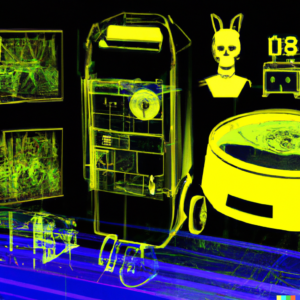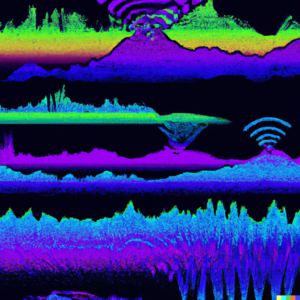Echoes of Tomorrow: Welcoming the Voice Assistant Era
Long before the advent of smartphones or even computers, humans have been fascinated with the idea of machines that could understand and respond to their voice. Literature and film are replete with examples, painting vivid images of futures where voices echoed through hallways, ordering lights on or off, or asking for the day’s schedule. Today, that vision isn’t relegated to the pages of a science fiction novel or the scenes of a futuristic movie; it’s in our homes, our cars, and even our pockets.
Voice assistants, powered by sophisticated Artificial Intelligence algorithms, have seamlessly woven themselves into the tapestry of our everyday lives. When was the last time you asked a question aloud and received an answer from a device, be it about the weather, a recipe, or traffic conditions? For many, it’s become as instinctual as asking another person in the same room.
Yet, while this technology may seem ubiquitous now, its journey from concept to household name has been one of persistent innovation and evolution. The story of vocal intelligence is more than just about convenience; it’s a testament to humanity’s unyielding drive to make the intangible tangible, to bring our wildest imaginings to life.
As we delve into the world of voice assistants, it’s essential to appreciate not only their capabilities but also the dreamers and innovators who believed that our voice, one of the most primal forms of communication, could be the key to unlocking a new era of interaction with the digital realm.
From Star Trek to Living Rooms: Voice Assistants’ Grand Journey
The story of voice assistants is deeply intertwined with the lore of science fiction. Decades ago, shows like “Star Trek” captured our imaginations with characters seamlessly conversing with their spacecraft, summoning information or giving commands with just a vocal request. These visions of the future set a benchmark, an aspirational standard that technologists would strive to attain in the real world.
The early attempts at vocal recognition were rudimentary at best. In the 1960s, IBM’s ‘Shoebox’ machine, one of the earliest voice recognition systems, could recognize a mere 16 words. It was a start, but it was a far cry from the conversational intelligence we had dreamt of. These early machines were rigid, often requiring slow, deliberate speech and being easily confounded by accents or variations in tone.
However, as with many technological narratives, the acceleration was exponential. The 90s and early 2000s witnessed significant strides, with systems like Dragon NaturallySpeaking allowing users to dictate to their computers. But true innovation lay just around the corner. The advent of cloud computing and more advanced machine learning algorithms in the late 2000s and 2010s revolutionized voice recognition. Devices no longer had to rely solely on their built-in processing; they could tap into vast cloud resources, leveraging immense datasets to refine and enhance their understanding.
Enter the era of Siri, Alexa, and Google Assistant. Launched in a world increasingly interconnected by smartphones and smart devices, these AI-driven assistants brought the dream closer to reality. Siri’s introduction on the iPhone in 2011 marked a significant milestone. It wasn’t just about voice commands anymore; it was about genuine interaction, understanding context, and delivering relevant responses. This was soon followed by Amazon’s Alexa and the Google Assistant, each bringing their unique strengths and further pushing the boundaries of what was possible.
Today, these voice assistants are more than just novelties or conveniences. They’re a testament to human ingenuity and the manifestation of our age-old sci-fi dreams. From turning on lights with a simple command to narrating recipes, setting reminders, or even offering companionship, they have bridged the divide between the fictional worlds of our past and the tangible realities of our present.
Meet the Vocal Titans: Alexa, Siri, and Google’s Symphony
In the realm of voice technology, three names tower above the rest: Alexa, Siri, and Google. These AI assistants have become household names, almost synonymous with the very concept of voice-enabled tech. Their rise to prominence wasn’t just due to technical prowess but also the perfect fusion of marketing, design, and evolving consumer needs.
Siri burst onto the scene in 2011 as Apple’s flagship feature on the iPhone 4s. A product of Apple’s unparalleled knack for design and intuitive interfaces, Siri quickly became the world’s personal assistant. Wrapped in Apple’s sleek design ethos and backed by its powerful ecosystem, Siri was more than just a functional tool; it became a cultural touchstone. Its sassy responses, coupled with a genuine attempt to understand context, made it not just a voice assistant but almost a digital companion.
Alexa followed soon after, introduced by Amazon in 2014. While Siri was bound by the confines of the iPhone and later the Apple ecosystem, Alexa’s domain was the home. Echo devices, with Alexa at their heart, sought to transform households. With a primary focus on smart home integration, Alexa could control lights, play music, set alarms, and even help you shop. Its open-skill system allowed third-party developers to expand its capabilities, turning Alexa into a versatile home manager. And with Amazon’s marketing muscle behind it, Alexa’s iconic wake word became a regular utterance in homes around the world.
Then there’s Google Assistant, Google’s answer to the burgeoning voice tech industry. Launched in 2016, it had the advantage of hindsight. Learning from the paths Siri and Alexa paved, Google Assistant integrated deeply with Google’s vast suite of services – from search to maps, from mail to photos. Its strength lay in its ability to pull data from these diverse sources, providing users with rich, context-aware responses. With the added advantage of Google’s search algorithms and data processing capabilities, the Assistant often felt eerily insightful, understanding user queries with a precision that seemed almost human.
Together, these three giants have shaped the narrative of voice technology, each carving out its niche and pushing the boundaries of what’s possible. They’ve set the gold standard for voice interaction, and as we move forward, their legacies will undoubtedly continue to influence the next generation of vocal AI innovations.
Behind the Echo: The Ingenious Tech of Voice Ais
For many of us, interacting with voice assistants feels almost like conversing with magic: you speak, and the machine responds, seemingly understanding your every word. But what really goes on beneath the surface of these sophisticated devices? Let’s peel back the curtain and delve into the intricate mechanics of voice assistants.
- Sound Capture: Everything starts with the device’s microphone. Modern voice assistants come equipped with advanced microphone arrays, designed to pick up the user’s voice from any direction, even in noisy environments. Noise-cancellation technology helps filter out extraneous sounds, ensuring that the voice command is captured as purely as possible.
- Voice to Text: Once your voice is captured, it undergoes a process called Automatic Speech Recognition (ASR). Here, the spoken words are converted into text. Machine learning models, trained on vast datasets of different accents, dialects, and languages, ensure that this conversion is accurate, making allowances for regional accents or colloquialisms.
- Natural Language Understanding (NLU): After ASR, the transcribed text is then processed by Natural Language Understanding algorithms. This is where the true ‘intelligence’ of the assistant comes into play. NLU determines the intent behind the user’s command. For instance, when someone says, “Play some relaxing music,” the NLU identifies the desire for music and the adjective “relaxing” to guide the choice.
- Response Generation: With the user’s intent clarified, the voice assistant then crafts an appropriate response. If it’s a query, the system might tap into vast knowledge bases or the internet to fetch relevant information. If it’s a command, the system will execute the desired action. In cases where the assistant is unsure, it might ask clarifying questions to the user.
- Text to Voice: The final step involves converting the generated response back into voice. Text-to-Speech (TTS) systems are employed, and they’ve become incredibly advanced, providing responses in natural, human-like tones. Brands even give unique voices to their assistants, making them more relatable and distinct.
In mere seconds, voice assistants traverse this complex journey, from capturing sound waves to delivering articulate responses. It’s a marvel of software and hardware engineering, underpinned by decades of research in linguistics, machine learning, and computational processing. While it feels like magic to us, it’s a testament to the genius of human innovation.
Beyond ‘Set an Alarm’: Voice Assistants’ Versatile Toolkit
The nascent days of voice assistants might have been dominated by requests like “Set a timer for 5 minutes” or “What’s the weather today?” But fast-forward to today, and these virtual helpers have outgrown such basic tasks, evolving into indispensable tools for a wide array of functions and services.
- Home Automation: Voice assistants are now the linchpins of smart homes. With a simple command, you can dim the lights for movie night, adjust your thermostat, lock the doors, or even start your coffee maker. They’ve seamlessly integrated with a plethora of home devices, making home automation feel effortless and intuitive.
- Health & Wellness: From reminding users to take medications to guiding them through meditation sessions or workouts, voice assistants have found a place in health and wellness routines. Some even analyze the tone of your voice to assess your emotional state, offering mood-lifting music or stress-relieving exercises as needed.
- Entertainment: Beyond just playing your favorite tracks, these tools can now serve as personal DJs, suggesting new music based on your preferences. They can read out audiobooks, offer movie recommendations, or even play interactive games with users, ensuring entertainment is always just a command away.
- Learning & Productivity: Need a quick fact check? Or perhaps language translation? Voice assistants are there to assist. They can schedule meetings, send texts, set reminders, or even tutor in various subjects, transforming them into personal secretaries and teachers.
- Shopping & Services: Some voice assistants, especially those tied to large e-commerce platforms, facilitate shopping experiences. “Order more coffee,” might result in your favorite brew being delivered to your doorstep. These assistants can also book cabs, reserve tables at restaurants, or even provide financial updates.
- Personalized Experiences: With advancements in AI, voice assistants are increasingly understanding user preferences and routines, offering highly tailored interactions. They might suggest a recipe based on what’s in your fridge, or remind you of your friend’s birthday and offer gift suggestions.
This vast range of applications signifies the transformative role voice assistants are playing in our lives. They’re no longer just a novelty; they’re ingrained in our daily routines, enhancing convenience, entertainment, and productivity. As their capabilities expand, we’re only glimpsing the tip of the iceberg in terms of their potential impact.
Listening In: The Ethics and Assurance of Vocal Tech
In a world where technological advancements continue at breakneck speed, the ethical implications surrounding them can sometimes lag behind. Voice assistants, as intimate and beneficial as they are, have inevitably raised eyebrows when it comes to user privacy. Their always-listening nature, coupled with the vast amount of data they collect, poses several questions: Where is this data stored? Who has access to it? Can it be misused?
- Always Listening, Always Recording?: One of the primary concerns voiced by users is the belief that these devices are perpetually eavesdropping. While it’s true that voice assistants listen for their wake word (like “Hey, Siri” or “Ok, Google”), they’re not always recording your conversations. Still, the possibility of accidental activations can lead to unintentional recordings, causing discomfort among users.
- Data Storage and Usage: When a voice assistant processes a query, it often sends the audio clip to cloud servers for analysis. This data can be stored and, in some cases, reviewed by human auditors to improve the system’s accuracy. This practice, when not transparently communicated, can feel intrusive to many users, leading to mistrust.
- Eavesdropping and Hacking: Like any internet-connected device, voice assistants are susceptible to hacking. Malicious parties could potentially access recordings or even use the device to eavesdrop in real-time, posing a significant security risk.
- Marketing and Personalization: As voice assistants learn more about user preferences, this data can be used for targeted advertising. While some may appreciate personalized suggestions, others view it as a blatant invasion of privacy.
Solutions and Safeguards:
Companies are increasingly aware of these concerns and are taking measures to address them. Many now offer clearer privacy settings, allowing users to opt-out of human review or delete stored recordings. Encrypted communications, regular software updates, and two-factor authentication are becoming standard to thwart hacking attempts.
Moreover, transparent communication about data usage and storage is becoming paramount. Companies are offering detailed privacy policies, educational resources, and settings to give users more control over their data.
While the future of voice technology is promising, it’s imperative to strike a balance between innovation and ethical responsibility. As consumers, staying informed and vigilant is crucial. At the same time, manufacturers have a duty to ensure that as voice assistants grow smarter, they also grow more respectful of our right to privacy.
Voice Forward: The Limitless Horizons of Vocal AI
The advent of voice assistants represents more than just a technological novelty; it marks a significant shift in how humans interact with machines and technology. The ease, immediacy, and intuitive nature of voice communication allow users of all ages and tech-savviness levels to harness the power of the digital age in the most natural way possible: by speaking.
But as with all innovations, voice assistants are just the beginning. As vocal AI continues to advance, we can anticipate a future where these tools become even more integrated into our daily lives. Imagine a world where voice commands control not just our smart homes, but also our vehicles, our workplaces, and even public spaces. A future where voice-activated AI can provide on-the-spot translations, making global communication seamless, or where it can assist doctors in diagnosing illnesses just by analyzing a patient’s speech patterns.
Ethical considerations, as discussed, will always remain paramount. The technology sector will be tasked with ensuring user trust and prioritizing privacy and security. However, as safeguards are developed and transparency becomes the industry standard, the potential benefits are boundless.
In wrapping up, it’s essential to appreciate that the age of voice assistants is a transformative period in technological history. We are moving from merely using devices to actively communicating with them, bridging the gap between human intuition and machine efficiency. And as we speak to the future, it’s listening, learning, and evolving to serve us better.







